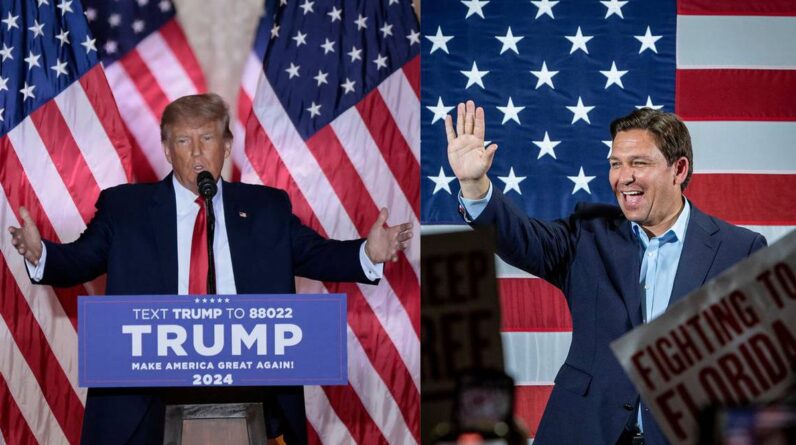
The apparent use by Gov. Ron DeSantis’ political campaign of fake AI-generated photos of former President Donald Trump hugging and kissing Anthony Fauci has raised concerns among experts about the new technology’s ability to deceive voters.
The images were part of a 40 second video posted last week by @DeSantisWarRoom on Twitter criticizing Trump, DeSantis’ main rival for the GOP presidential nomination, for not firing Fauci, an infectious disease expert who served on the White House’s coronavirus task force. Many Republicans say Fauci advised keeping businesses and schools closed unnecessarily during the pandemic.
The realistic-looking footage was likely generated by AI technology and appeared to show Trump and Fauci embracing in various locations around the White House. The fake images were interspersed with real photographs of the two men together.
The video, posted by the DeSantis campaign Twitter account, was the latest example of the campaign’s use of generative artificial intelligence, which can create lifelike images with a few prompts, in the attacks. and clone human voices.
Donald Trump became a household name FOR countless people *on TV*
But when it came to Fauci… pic.twitter.com/7Lxwf75NQm
— DeSantis War Room 🐊 (@DeSantisWarRoom) June 5, 2023
In May, Trump shared a two-minute parody video on Truth Social and Instagram of DeSantis’ presidential announcement that made it look like DeSantis was making his announcement alongside the devil, Adolf Hitler and others. And Donald Trump Jr. days after shared a video which replaced Steve Carell’s character from the hit show “The Office” with a figure who looked and sounded like DeSantis. In the scene, the sitcom characters make fun of Carell’s character for unknowingly wearing a woman’s outfit.
DeSantis seems to spend a lot of time in high heels 🤣🤣🤣pic.twitter.com/0Q43xzZskM
—Donald Trump Jr. (@DonaldJTrumpJr) May 26, 2023
These videos appeared to have been created by other usersnot the Trump campaign, and the altered footage and audio appeared so that the viewer would easily know they were manipulated, although neither disclosed that they were generated by AI.
The line between real and fake was further blurred with fake photos of Trump kissing Fauci. And that could happen more and more in the future, said Janet Coats, director of the University of Florida’s Media and Technology Trust Consortium.
Coats said generative AI will become more common, sophisticated and difficult to separate from real life as the technology improves and the 2024 election approaches.
There are already a wide variety of free or cheap voice cloning apps available online that are relatively easy to use. Many require a short audio sample of someone speaking, which can then be used to generate audio of someone saying whatever the user would like.
Learn about Florida politics
Subscribe to our free Buzz newsletter
We’ll send you a roundup of local, state and national politics coverage every Thursday.
You are all registered!
Want more of our free weekly newsletters in your inbox? Let’s get started.
Explore all your options
“We’re in an arms race until November 2024,” Coats said. “Right now, people have their toes in the water, but as they see what it can do, I think there will be more and more. The ability to check it will be more difficult, because it will flood us a lot.”
The Republican National Committee sparked a conversation about the use of AI in political messaging last month after releasing a 30-second dystopian portrait of what it said would be America if President Joe Biden is re-elected. The video contains a disclaimer in the upper left corner stating that the images were generated by AI.
The American Association of Political Consultants in May condemned the use of deceptive AI-generated content in political campaigns.
After the DeSantis campaign released the video of Trump and Fauci, a note from the Twitter community flagged the post, warning readers that the video contained fake AI-generated imagery. AFP Fact Check was be the first to flag fake photos.
Some Republicans rejected DeSantis’ campaign.
“Smearing Donald Trump with fake AI images is completely unacceptable.” said Senator JD Vance of Ohio, who has endorsed Trump for another term as president. “I don’t share them, but we are in a new era. Be even more skeptical of what you see on the Internet.”
U.S. Rep. Marjorie Taylor Greene of Georgia, an avid Trump supporter, too criticized the ad, saying the post should be taken down.
It was also speculated that a May 24 DeSantis announcement used AI to include fighter jets flying over the governor during a speech. It is unclear whether the added jets were the product of AI or manual digital alteration.
On June 8, apparently dismissing the criticism, DeSantis Rapid Response Director Christina Pushaw published a screenshot of a Trump post on Truth Social featuring Ron DeSantis riding a rhino in what appeared to be an insinuation that DeSantis is a Republican in name only, or RINO. Pushaw wrote above the screenshot: “I think it might be an AI generated image. Who knows?”
Asked about the Fauci-Trump footage, a Trump spokesman responded: “Fake footage from a fake campaign for a fake candidate. This stunt had the ‘please clap’ energy of Ron DeSanctimonious’ mentor, Jeb Bush.”
The DeSantis campaign did not respond to multiple emails seeking comment.
On June 5, Democratic US Rep. Ritchie Torres of New York introduced a bill this would require a disclaimer for AI-generated content.
While the public knows that AI-generated images and audio exist, the risk is that as the technology improves and becomes more common, this content could become “visual clutter” that people don’t take in or look at critically, Coats said.
Campaigns can also try to use AI to backtrack on positions listed above by altering the actual content or claiming that the actual content was generated by AI, Coats said.
“If there’s so much of it that it’s no longer easily discernible that this is not real, this person didn’t say this, this is disinformation, misinformation … it gets very, very complicated,” Coats said.
[ad_2]
Source link





